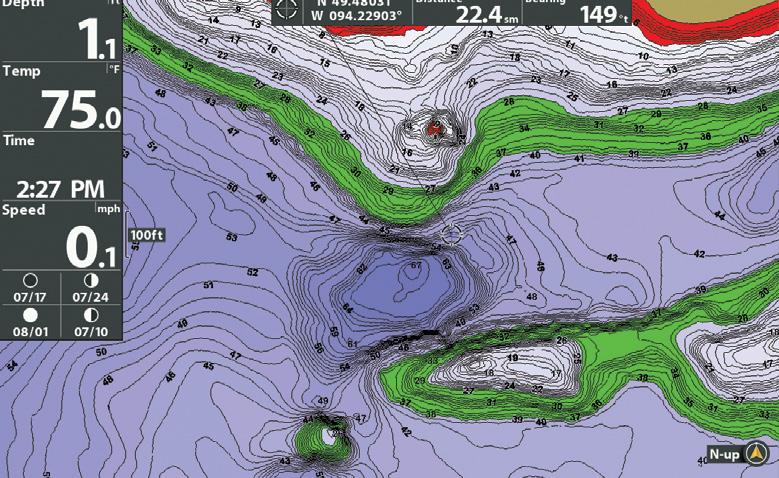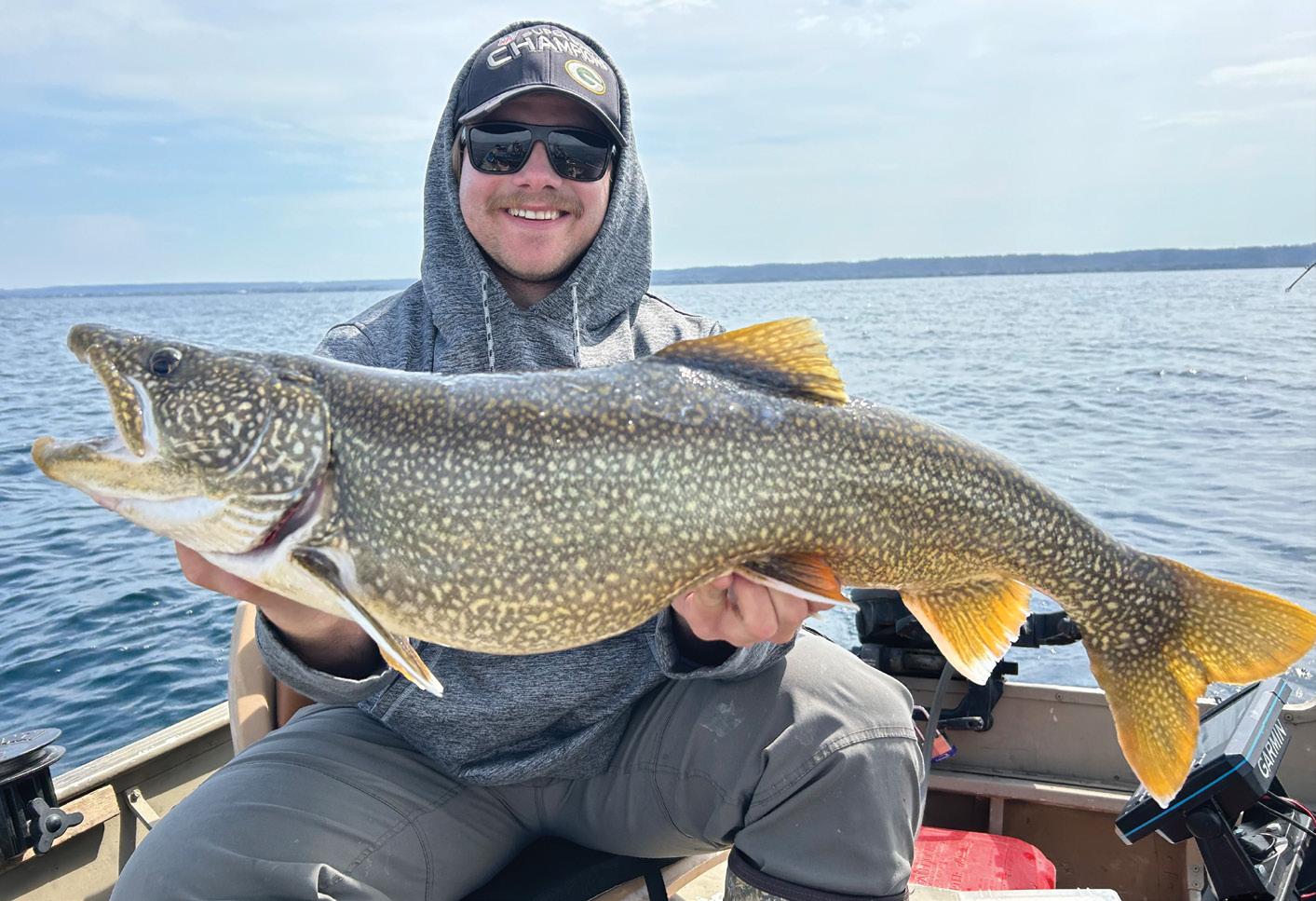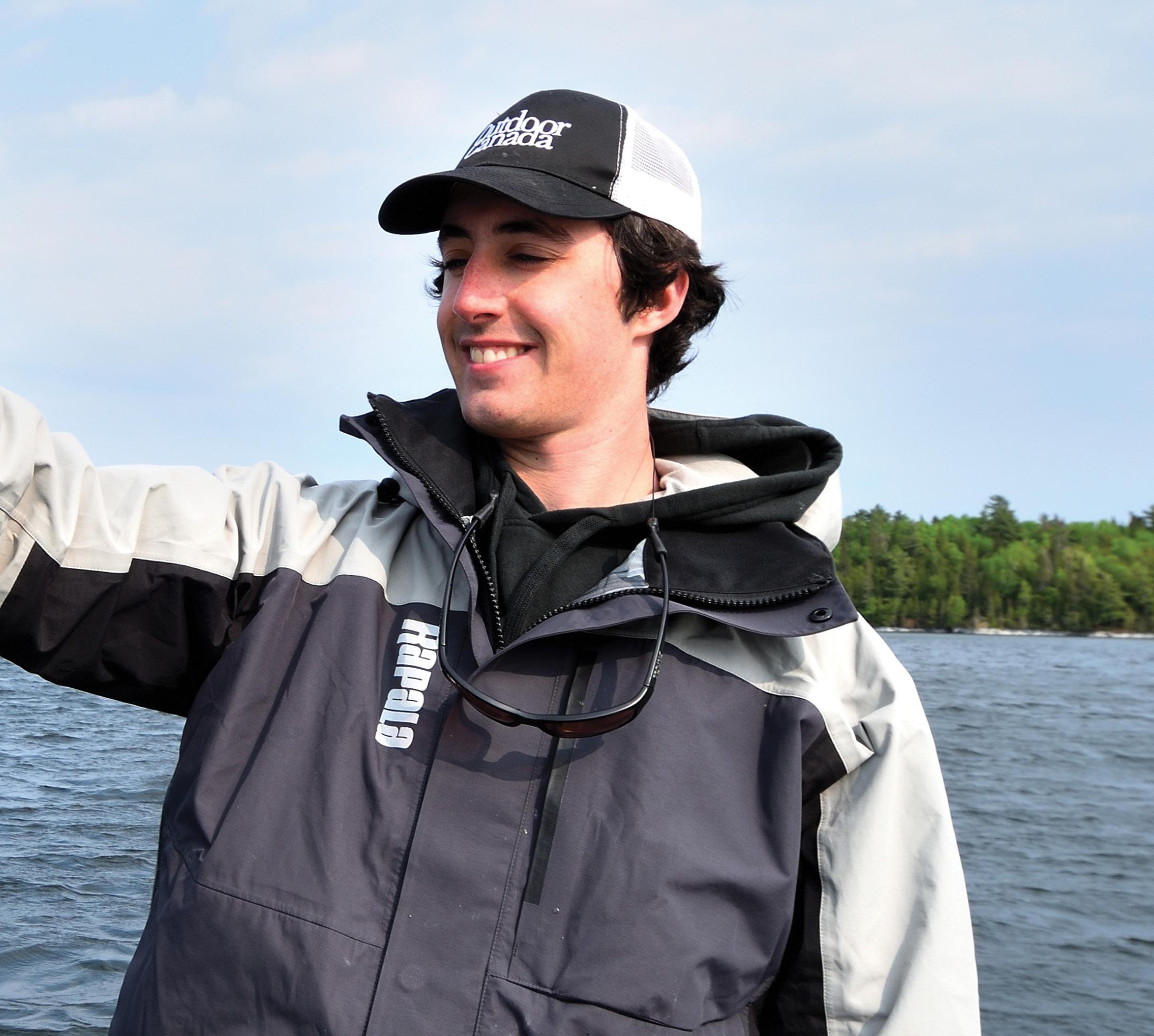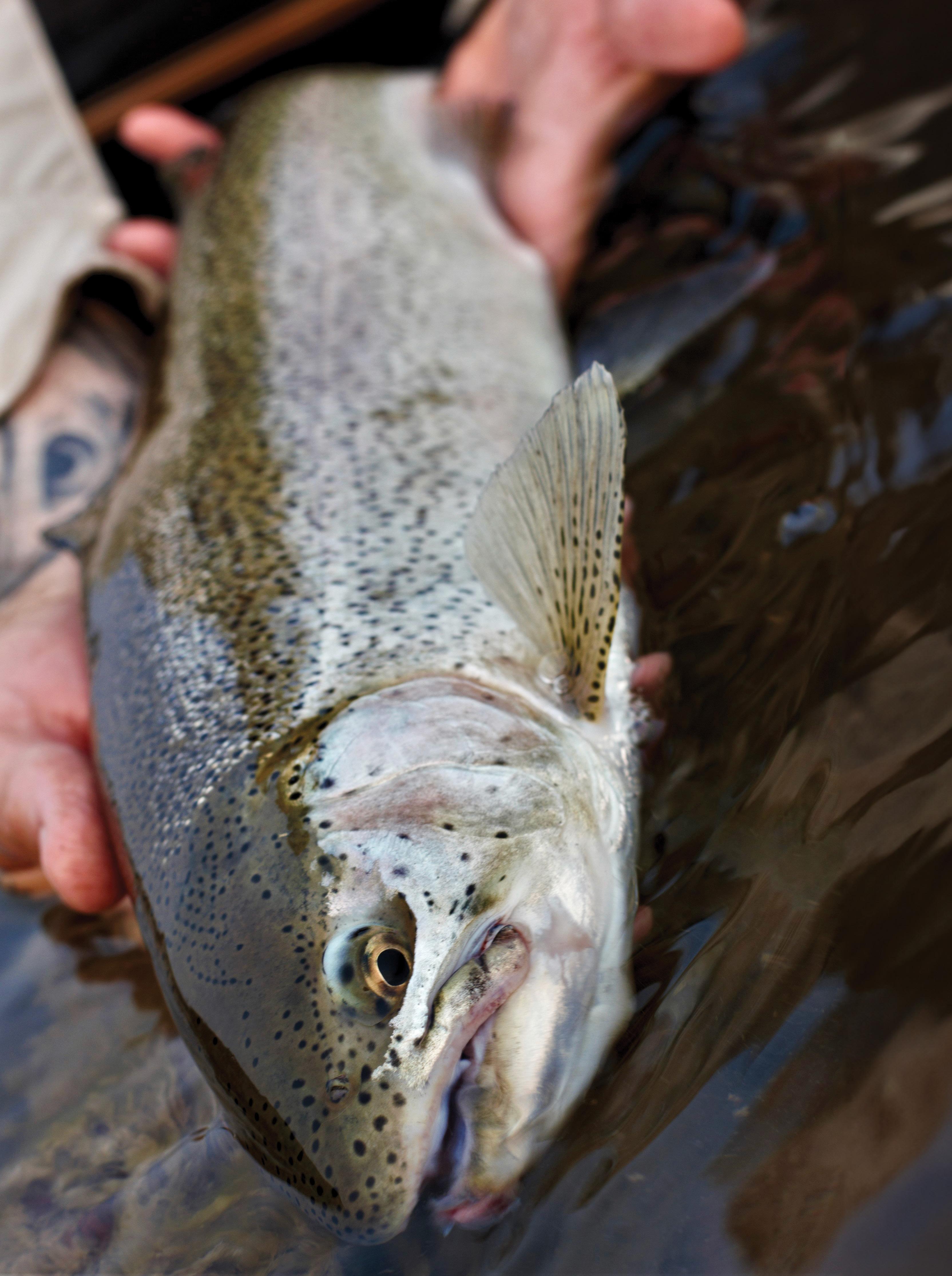
7 minute read
FORAGE FREE-FOR-ALL
BY GORD PYZER
Learn The Lake
Advertisement
The first step is to understand that most of our lakes are split into three separate and distinct zones of water from late spring through autumn. First there’s the warm 25- to 35-foot upper layer of surface water, known as the epilimnion. Then there’s the deep cold basin zone known as the hypolimnion, and separating the two is the eight- to 15-foot belt-like layer called the metalimnion, or thermocline. It functions like an invisible barrier restricting movement between the upper and lower sections. You can’t see it, but if you dive down into it, you will feel it, because the water temperature will plunge at least one degree per foot of descent.
Locating the thermocline is critical, because it’s the zone where ciscoes gravitate and thrive. It’s so profoundly important, in fact, that many biologists refer to it as the “cisco layer.” I like to call it something else—the shooting gallery. That’s because ciscoes bunch up so tightly in the thermocline that predator fish shoot up and down into it to get their favourite food.
Fish are cold-blooded creatures, so the only way they can regulate and control their body temperature is to swim in water that has the ideal temperature for their survival. Walleye, bass, pike and muskies are referred to as warmor cool-water fish because their preferred temperatures are found within the epilimnion. Lake trout, burbot and whitefish, on the other hand, are cold-water loving species, with their optimal water temperatures typically found in the hypolimnion. Again, ciscoes are sandwiched between those two precincts, with their greatest abundance typically found in water temperatures ranging between 10°C and 14°C.

“Ciscoes dominate the thermocline due to the competing tradeoffs between food availability, predation risk and metabolic drivers like temperature and oxygen concentration,” Therrien says. “At the thermocline, zooplankton densities are highest as a result of seston accumulation (carbon debris) that zooplankton feed on between the epilimnion and hypolimnion. Zooplankton is the major component of cisco diets, so it is profitable for them to stay at that depth.”
In terms of predator avoidance, the thermocline is an advantageous habitat for ciscoes to be in, as their major predators have more generalist foraging strategies. “If ciscoes can move away spatially from the other sources of prey, then their predators have to make a choice to pursue them,” Therrien says. “We can hypothesize that not all predators will make that decision, and some will instead forage for other prey away from them.”
The thermocline also has the optimal temperature and oxygen concentration that ciscoes require. “This is important, because to avoid predators, ciscoes need to optimize their metabolic rate, while keeping it low enough to not unnecessarily lose energy,” Therrien says. In short, ciscoes know they have a target on their backs, and that the predators have their crosshairs on them. The trick for anglers is to put that predicament to their advantage.
Target The Thermocline
Throughout the fishing season, before I even make a cast, I slowly drop down my water thermometer to the bottom of a deep section of the lake. I let it remain there for a couple of seconds, then slowly bring it back up the surface, where it tells me the exact temperature at every five-foot interval. I take particular note of the depth at the top and bottom of the thermocline, where the temperature drops dramatically, with the values ranging between 10°C and 14°C.
Let’s say we’re fishing for walleye and pike, and the thermometer tells us the top of the thermocline is located about 24 feet down, while the bottom is at 38 feet. Now it’s simply a matter of scanning an underwater contour map of the lake to identify every potential walleye and northern pike structure— underwater point, reef, saddle, rock pile and shoal—that comes into contact with this band of water.
I did just that on one of the steamiest August days on record several years ago while fishing with two anglers from Saskatchewan. We simply retrieved 3 4- and one-ounce jig heads tipped with six-inch swimbaits across mid-lake shoals that plateaued out at approximately the same depth as the top of the thermocline. And to solidify our chances of success, the swimbaits were silvery white in colour and slender, just like ciscoes. In all, we landed 11 walleye weighing more than 10 pounds, topped off by a 35-inch, 15-pound Goliath that was one of the biggest walleye caught in North America that year.
Cisco expert Christian Therrien (left) says predators find the silvery prey fish so delectable that they’ll vacate their preferred warm, shallow comfort zones and venture into much colder, deeper water to find them. Therrien says he’s caught smallmouth bass 40 feet down while trolling for lake trout and northern pike at depths of 90 feet, for example.

These days, I like to go a step further, using my Helix 12 chartplotter and LakeMaster VX chip and program in the top and bottom depths so I can see the high-percentage ciscobearing water highlighted in colour, where it intersects with each structure (see chart above). Talk about opportunity meeting preparation.

Throughout the open-water season, this strategy is responsible for many of the biggest pike, muskies, smallmouth bass and lake trout I catch. And all it takes is navigating the subtle ups and downs of the thermocline based on the local weather conditions, and a change of baits or tweaking of presentations based on the targeted predator. For northern pike and muskies, for example, the only alteration or modification I typically make is to swap out the 10- to 15-pound monofilament or fluorocarbon walleye leader for an ultra-thin, nearly invisible 13-, 20- or 26-pound leader of tie-able stainless steel. When I hook a fish with my heavy paddletail, the only question is whether it is a walleye, northern pike or muskie. When I want to minimize catching walleye and concentrate more on big toothy critters, I’ll switch to a much bigger, cream-coloured Bondy Bait or Water Wolf Shadzilla. Typically, I vertically jig the Bondy Bait around the rim of the structure, keeping it within a few feet of the bottom at all times. With the Shadzilla, I cast it out and let it sink to the bottom before retrieving it back to the boat.

Let It Hang
By now, the latest secret is out about catching cisco-crunching smallmouth bass, thanks to Kenora, Ontario’s Jeff Gustafson winning the prestigious 2023 Bassmaster Classic. Hanging a four-inch cisco-impersonating, fluke-style bait— super-glued to a 3⁄8-ounce Nishine Smelthead jig—is as simple and as deadly as it gets. About the only thing that will shock you is how many of the vicious strikes arrive at the side of the boat in the form of a giant walleye or mammoth northern pike instead. The fish just can’t tolerate seeing a lonesome solitary cisco above their heads, suspended in the middle of the water column. Watch your lure on the sonar screen and you’ll see a mark appear below it, then streak up and annihilate it. But wait, it can get even better. Let’s go back to that scenario where »
LOOK-ALIKE LURE
When angler Ken O’Brien caught his 65-pound Ontario record muskie (left) on Georgian Bay in 1988, he was trolling without a leader for whatever would bite. His bait of choice? Perhaps not surprisingly, a four-inch Rapala Countdown—the quintessential cisco imitation.

Suspended cisco imitations will fool smallies, as well as coldwater predators the water thermometer told us the bottom of the thermocline—the cisco layer—was 38 feet down. This time, slide over to a nearby 45-foot hump and dangle the same flukestyle cisco bait over the top of it. You can even use your electric trolling motor, set on a low speed, to slowly stroll the bait off the edge, over 50, 60, even 70 or more feet of open water. Just be sure you’ve got a good grip on your rod because the lake trout hiding in ambush in the shadows below will try to rip it from your hand. This tactic is so exciting and effective, I rarely troll for lakers anymore. What we’re doing here is calling up cold-water predators such as lake trout and whitefish to the base of the thermocline to attack our cisco-masquerading baits. At the same time, we’re pulling down the warm-water plunderers to the top of the roughly 15-foot-thick band of water, where a disproportionate amount of the predators’ favourite food is concentrated.
Hit The Fall Shallows

Like all good things, the ciscoshooting gallery shuts down with the erosion and eventual elimination of the thermocline during fall turnover. Instead of cisco-based patterns petering out, however, they actually strengthen instead— so much so you almost have to feel sympathy for these baitfish. Their Achilles heel? They spawn in late fall on shallow gravel shorelines and shoals, often in natural or windinduced current areas, such as constricted channels.
Knowing this, the biggest walleye, bass, muskies and pike, in particu-


Room To Grow
The preferred water temperature for the growth and survival of many fish species changes as they mature and grow bigger. Large walleye and northern pike, for example, seek out deeper, colder water to reduce their metabolism and devote more energy to the production of eggs. They achieve this by moving more closely to the thermocline, where they can prey heavily, often specializing on ciscoes. It’s an outrageously brilliant adaptation.
lar, will wait at the prime intersections and maraud the arriving migrants. It’s often a bloodbath, occasionally revealed by floating cisco carcasses on the water’s surface. For this reason, I always look for fish-eating birds, especially bald eagles and gulls, squawking chaotically and diving onto the surface, or perched up high in nearby trees.
The key is locating the best rock structures—including sea gull rocks, whale backs, shallow boulder shoals and saddles—that lie in the path of the incoming cisco schools. I have one favourite tiny island point on Rainy Lake, for example, where so many huge predators group up and wait for dinner to arrive that you can’t predict what will hit your bait next. One cast it will be a gargantuan northern pike, the next a double-digit walleye and the third a plump smallmouth stuffed with so many ciscoes it spits them out as you bring it to the net.

On another lake, I have a similar spot where it’s deep on one side of a piece of structure and shallow on the other. The same multi-species fall brawl plays out there, too. One time, when my grandson Liam was young, we were duping chunky walleye by retrieving cisco-imitating paddletails. Liam hooked an obviously big fish, and I watched his rod double over dangerously as he yelled for me to grab the net. I took my time, thinking it was a large walleye. I barely had the net in my hand, however, when one of the biggest smallmouth bass I’ve ever seen erupted from the water right beside the boat, and cartwheeled four feet into the air. I swear it looked me straight in the eye as it twisted and turned— and spit the hook. Such is the drawing power of ciscoes. OC
ALSO SEE PAGE 24 FOR FISHING EDITOR GORD PYZER ’S NED RIG ADVICE.




